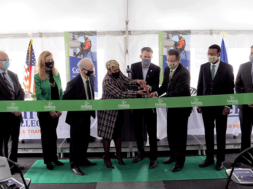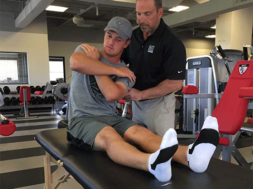
3D Course Design, Competency-Based Online Learning, and Why Distance Education Earned a Bad Name
By Dr. Joel A. English, Vice President, Centura College, Aviation Institute of Maintenance, and Tidewater Tech
Institutions that are new to online learning and those who have enrolled online students for years need to stop and ask a vital question: What should an online course look like? In a traditional classroom, we know what we expect our faculty to do. They come to class with something to say, something to teach. But they rely on student interaction to move our lecture into discussion – turning teaching into learning. And then, after that grand “talky chemistry” takes place, students respond by doing something. Students may write, solve some problem or apply knowledge to practical situations, or go conduct some research or group activity. Ultimately, homework, experimentation, lab work, and research assignments ask the student to respond and apply knowledge that was born during lecture and discussion.
That’s the traditional classroom. But what is an online course supposed to do? In the first few decades of online learning, I think we all but ignored what we actually believe about learning just to see if we could put college courses online! The online products we developed generally earned very little respect, and for good reason.
I want to take a look at why the first generation of online learning earned a bad name, and what online courses need to accomplish to improve upon their performance in years to come.
What is 3D course design?
Obviously, the online course seeks to accomplish the same “3D” approach to learning: dialectic, discussion, and deployment. Generally speaking, we’ve accepted that there are three main learning styles that we try to engage within the classroom: auditory, visual, and kinesthetic. Auditory learners are most engaged through text, lecture, discussion, and other verbal presentations of material. Visual learners process and retain information most readily when presented with graphical, colorful, tactile, or otherwise visually-applied material within the learning process. Kinesthetic learners are those who are most engaged with hands-on application, active response, or personal research and experimentation. Students who fall asleep no matter how intellectually stimulating the discussion may get or how many YouTube videos we bring into the classroom may be kinesthetic learners, who will only wake up when we let them take over and do something.
So, the well-designed classroom – that is, the classroom that successfully engages the most learners – is the classroom that engages all three learning styles, combining verbal lecture and visual representation (dialectic), with verbal correspondence and visual interaction (discussion), and practical application, including research, experimentation, and writing (deployment). None of this is new. I’m just calling it “3D” to sound clever.
Why does online learning stink?
Unfortunately, online courses have traditionally relied too heavily on auditory learning activities and all but ignored the visual and kinesthetic learners.
When web-based online courses first began surfacing in the 1990’s, online education clearly and definitively over-emphasized auditory learning.
In those days, online courses mostly meant reading. Students would read a chapter in a textbook, and then they would read a simple HTML lecture written by the instructor. They would read a discussion question, write a response, and then read what the other students and instructor said about it. They would then write a paper or a written exam, which the teacher would read, and then write comments back, which the student would read. Maybe there was also a chat room involved, in which students and instructors wrote and read. It was all reading! Auditory learners might have found this style of online instruction sufficient, but the rest of us fell asleep at the wheel. We all agreed: online classes were boring.
Up until recently, the general popular consensus was that online courses were somehow “less than” brick-and-mortar learning. My theory is that this was because the first decade or so of online learning was almost completely auditory – almost completely reading and writing. I agree with the popular vote: This early version of online learning is, by definition, less than! We all can go ahead and agree on that right now. If we generally believe that the best instruction engages auditory, visual, and kinesthetic learners, but online learning 1.0 featured nothing but auditory learning, then those courses were not as good as residential courses, which engaged all three.
We should have known better. And possibly we did, but the Internet just hadn’t caught up to good pedagogy, and we hadn’t figured it out yet, either. With modem speeds to worry about, video being all but impossible, browsers unstandardized, instructional design methods undeveloped, and institutional competition not a factor, our online courses were flat. They stunk. No wonder the phrase “online college” is still racked with stigma!
The Internet got better
But by the mid-2000’s, we began to bring in instructional design software such as Camtasia and other screen capture software that could take our PowerPoint slides, and imbed the instructor’s audio lecture content. Suddenly, online lectures were not just auditory, they were also visual. Obviously, we’ve progressed beyond a death-by-PowerPoint world (mostly sparked by the ubiquitous streaming video standard that is YouTube), and we can all-but assume that every student can view even the most detailed video lecture through streaming sites such as YouTube and Vimeo. Add to that the Web 2.0 technologies that most Learning Management Systems are built on, and today’s online course simply has no excuse but to be equally auditory and visual. We’ve gotten better.
All this said, remember those classroom sleepers we mentioned – those poor kinesthetic students who are not stimulated, no matter how talky and eye-catching our lectures might be? The good news is that the online course actually has a natural advantage for kinesthetic learners, because those students are engaged simply by navigating the LMS and going to class. Logging in can sometimes irritate our auditory learners or confuse our visual learners, but kinesthetic learners are online moving around with ease.
That’s great, but here’s where course design actually must play in. We have learned that we need to think in terms of shorter segments of instruction within online courses. We no longer think in terms of a 50-minute class session or a 90-minute lecture when we build a quality online course. Rather, we think in terms of a 5-8 minute lecture, which moves to online discussion, which in turn moves to an activity that applies that learning. An online lesson must be structured to include the various learning styles, and that structure cannot flow extemporaneously from the teacher’s mind in real time, like it does in a traditional classroom. In the classroom, we can see it in the student’s eyes that we need to stop lecturing, field questions, show a demonstration, let them try it, and come collectively to the utopian a-ha moment. A-ha’s don’t happen the same way in online courses.
While a traditional classroom instructor may be the “conductor” to create understanding for her students, the online course developer must become the “architect” of learning moments by crafting dialectical instruction, discussion moments, and deployment activities that follow.
The future of online learning is adaptive
Probably the best embodiment of this “3D course design” takes the form of what we call “adaptive learning” – courses that present audio/visual instruction in a direct combination of skill and knowledge testing, and the course itself adapts the amount, detail level, and depth of further instruction based on the student’s mastery (or lack thereof) of the material being presented. Adaptive lectures employ a sort of “shape shifting” methodology, where the actual course itself teaches content to students, assesses what they’ve learned and what they already know, and morphs right in front of the student in response to their aptitude, presenting the appropriate level of instruction for each individual student.
Adaptive technology can be expensive, takes a maximum amount of development time, and is more complicated than most of us mere mortal school operators can put together. Currently, publishers such as Elsevere and McGraw Hill are abandoning traditional online course development for adaptive courses, which prepare students for nursing and other medical-related certifications and serve out a “just in time” approach to learning, preparing students to demonstrate competency and mastery of material efficiently and in a customized way. Probably the most successful designer of adaptive courses is Fulcrum Studios (formerly Adaptive Courseware) out of Hollywood, CA, who has designed dozens of beautiful and elegant college-level courses using adaptive pedagogy and technology. Fulcrum’s most recent courses train students for high stakes standardized courses such as SAT, GRE, and Federal Aviation Administration certification exams by first gauging students’ baseline knowledge, and then serving out only the educational content they need to become proficient enough to pass the upcoming exam. As most of us are aware, the U.S. Department of Education, our states, and our accreditors are waiting for us to innovate true competency-based only learning, which promises to provide a speed-to-mastery approach for learners to demonstrate certifiable skills, and adaptive course design is the only way that online learning will be able to rise to this challenge.
The current problems with creating adaptive courses are time and money. To create the kinds of knowledge question banks, responsiveness to student interactions, and quality educational content required in an adaptive course, an institution needs not only instructional designers to create the course content, but also coders and programmers to make the course shift its shape in response to the student’s competence and performance. If you visit the Fulcrum Studios office in Hollywood, you will see dozens of graphic artists, programmers, illustrators, project managers, and instructional designers – and that’s just in the design suite. You will also visit the filming studio where actors, directors, and producers are working to film lesson after lesson – many of which wouldn’t even be seen by a student if their beginning competence tested them out of that content. At this point, there simply is not an “Adaptive Course in a Box” option for quality adaptive, competency-sensitive online course development. There’s no easy way to develop an excellent adaptive course.
So, what can we do at our own institutions as we build quality online courses (if we don’t have the significant funding and skills needed to develop adaptive courses)? All online course developers should assure that their courses are designed to juggle between the visual, the auditory, and the kinesthetic.
Quality online courses must present short and attractive lectures that feature text, audio, and video content, quickly moving concepts to discussion threads or chats, allowing for discourse between peers and instructors.
3D courses weave instruction with assessment, continually engaging students in activity, thought, listening, watching, producing, submitting, testing, and yes, even reading.
Quality “3D courses” are multi-media and multi-modal. Students must not be expected to just sit read (like they did in online courses from the 90’s), nor quietly pay attention to a lecturer (students don’t listen any more). Rather, students must be asked to watch, interact, respond, produce, engage in discussion, and deploy hands-on skills, all within the online environment, and do so with fast-paced switching back and forth. An online course should look loud. It should replace talky with do-ey. If we strive for the multi-modal and teach to the various learning styles, we have the opportunity to claim a new esteem for online learning and reach our students more successfully online.

DR. JOEL ENGLISH is the Vice President for Operations of Centura College, Aviation Institute of Maintenance, and Tidewater Tech, where he supervises all operations over the 20 campuses across the country. Dr. English served as a Commissioner for the Accrediting Commission of Career Schools and Colleges for six years and the Chair of ACCSC for two years, as well as chairing the Distance Education Committee. In previous positions, Dr. English served as the CEO for the Ohio Centers for Broadcasting, Illinois Centers for Broadcasting, and Miami Media School, a family of schools dedicated to technical education in radio, television, and internet media broadcasting. He also oversaw distance learning and school operations at several campuses as a Regional Director and Executive Director at Centura College, and he was formerly an Assistant Professor of English and Distance Learning at Old Dominion University. Dr. English recently published Plugged In: Succeeding as an Online Learner through Wadsworth/Cengage Learning, as an extension of his dedication to supporting student success within online courses and programs. Dr. English holds a Ph.D. in Rhetoric and Composition from Ball State University, and an M.A. and B.A. in Technical and Expository Writing from the University of Arkansas at Little Rock.
Contact Information: Dr. Joel A. English // Vice President // Centura College, Aviation Institute of Maintenance, and Tidewater Tech // jenglish@centura.edu










